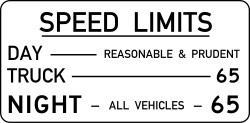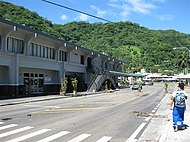Speed limits in the United States by jurisdiction
Municipalities are normally required to seek approval from the State Traffic Commission for changes to the posted speed limits on locally owned streets after appropriate engineering studies are performed.
For the most part, these night time reduced speeds are located in wildlife preserves for such endangered species as the Florida panther and the key deer.
However, a new law has permitted urban interstates to now be posted as high as 70 mph,[48] and some have already reflected this change, such as I-95 through Brunswick, I-85 in Gwinnett County, I-75 in Macon, Valdosta, and Tifton, and I-185 in Columbus .
Some interstates in small cities (e.g. I-55/74 through Bloomington-Normal, I-39/90 through the Rockford area, I-57 through Champaign-Urbana) do not have reduced speed limits, and stretches of I-90 and I-355 in the Chicago suburbs are also signed at 70 mph.
On February 6, 2012, the Indiana Toll Road was raised from the Illinois state line to mile marker 20 to 70 mph (113 km/h) after a major highway reconstruction project.
[70] Louisiana's highest speed limit is 75 mph, found on 154 miles of Interstate 49 in Saint Landry, Avoyelles, Evangeline, Rapides, Natchitoches, DeSoto and Caddo parishes.
In August 2003, Governor Mike Foster announced speed and lane restrictions on trucks on the 18 miles (29 km) stretch of I-10 known as the Atchafalaya Swamp Freeway.
This includes the expressway grade roadways like US 50 and US 301 east of the Bay Bridge, US 15 north of Frederick to the Pennsylvania state line, MD 404 around Denton and US 29 between I-495 and I-70.
[84] MDOT and the MSP announced on April 26, 2017, that the speed limit was increased to 75 mph on several Michigan freeways, including I-75 from Bay City to Sault Ste.
Furthermore, speed limits in smaller cities, including Ann Arbor, Battle Creek, Flint, Kalamazoo, Lansing (the state capital), and Saginaw remain at 70 mph (113 km/h).
A 20-mile (32 km) stretch of US 127 between St. Johns and Ithaca was posted at 65 mph (105 km/h), as a compromise to allow a freer flow of traffic due to insufficient funds to improve the section to freeway standards.
In 2017 speed limits began increasing to 65 mph on several select two-lane roads in both the Lower and Upper Peninsulas of Michigan, including US 2 from St. Ignace to Rapid River and M-28 from I-75 to Munising.
97–486 on December 23, 1998; it held that a law requiring drivers to drive at a non-numerical "reasonable and proper" speed "is so vague that it violates the Due Process Clause ... of the Montana Constitution".
In 2015, the Nevada State Legislature voted to increase the statewide maximum speed limit to 80 mph to take effect in October of that year.
On March 13, 2017, the Nevada DOT installed 80 mph speed limit signs on the 130-mile stretch of I-80 between Fernley and Winnemucca, excluding the Lovelock (exits 106 and 107) area.
New Jersey's only statutory speed limits are: Since the state is largely suburbanized, it ranges between 25 and 50 mph depending the jurisdiction of the road and whether the municipality is township, village, town, borough or city status.
Until September 2003, the state legislature needed to approve individual 65 mph zones, a lengthy process taking months or years of politically motivated debate.
Then-Governor George Pataki signed legislation in September 2003 that enables NYSDOT and New York State Thruway Authority to raise speed limits to 65 mph on its roads that meet established design and safety standards.
North Carolina operates a Safe Driving Incentive Plan (SDIP),[130] a program that leads to insurance surcharges for moving violations based on a point system.
On May 9, 2016, Governor Fallin signed HB 3167 which removes numerical caps on rural highway speed limits in Oklahoma which took effect in November 2016.
In 1940, when the Pennsylvania Turnpike was opened between Irwin and Carlisle, the entire 160 mile limited-access toll road did not have a speed limit, similar to that of the German Autobahns.
On May 2, 2016, PennDOT announced that the speed limit would be increased to 70 mph (115 km/h) on about 800 miles (1,300 km) of roadway across the state, including rural stretches of I-79, I-80, I-99, I-380, and US 15,[151] with conversion to take place on May 3.
This is not enforced for slow-moving trucks in areas with steep grades and signs are posted that instruct drivers to use their flashers if traveling below 50 mph (40 if the speed limit is 55).
[155] In October 2018, Governor Tom Wolf signed into law a bill authorizing the use of speed cameras in active construction zones on Interstate highways.
[200] Initial studies found that lower speed limits could provide roughly 1.5% of the emissions reductions required for Clean Air Act compliance.
Concerns about safety problems and enforceability of such a large differential (up to 15 mph on many roads) scuttled that proposal, and a compromise plan, described above, was enacted that retained uniform, but still reduced, speed limits.
[citation needed] On April 3, 2013, Utah Department of Transportation spokesman John Gleason said "We’d only do it in a situation that would make sense: flat, straight roadways.
"[225] The same statute contains a number of exceptions, however, allowing higher speed limits "where indicated by lawfully placed signs, erected subsequent to a traffic engineering study and analysis of available and appropriate accident and law-enforcement data".
In 2019 the West Virginia Legislature passed a resolution allowing WVDOT to raise speed limits on interstates to 75 mph based on safety and traffic studies.
Outside of built-up areas (these include denser business, industrial or residential land uses according to the relevant law) a 55 mph (89 km/h) limit is effective in the absence of other indications.





















